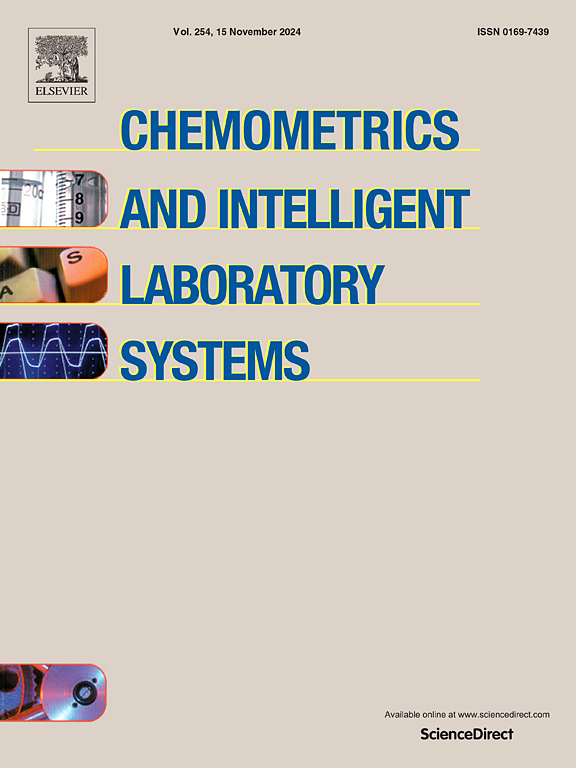Computing eccentricity based topological indices of silicate network with applications to QSPR/QSAR analysis
IF 3.8
2区 化学
Q2 AUTOMATION & CONTROL SYSTEMS
Chemometrics and Intelligent Laboratory Systems
Pub Date : 2025-05-04
DOI:10.1016/j.chemolab.2025.105424
引用次数: 0
Abstract
Topological indices are one of the useful tools in graph theory provided by chemists, which is a numeric quantity that helps to predict physico-chemical properties of chemical compounds. To classify molecules and model unknown structures the topological representations of molecular structures with the necessary properties can be used. The topological indices of distance-based methods are advanced tools that show effective significance in chemical graph theory (CGT). In recent years, many topological indices (TIs) have been studied and applied in theoretical chemistry and have been widely used to investigate quantitative structure-property relationships (QSPR), and quantitative structure-activity relationship (QSAR) research, and to evaluate networks. In this paper, the various eccentricity-based topological indices were calculated for the silicate network and plotted as 3D graphs for each calculated indices. In contrast, physico-chemical properties such as ‘boiling point (BP), enthalpy (E), molecular weight (MW), complexity (C), molar refractivity (MR), polar surface area (PSA), and refractive index (RI)’ were computed for silicate compounds using a linear regression model and plotted graphs for each properties with the values of correlated coefficients. These results have been used for the development of drug delivery systems.
基于偏心率的硅酸盐网络拓扑指数计算及其在QSPR/QSAR分析中的应用
拓扑指数是化学家在图论中提供的一个有用的工具,它是一个数值量,有助于预测化合物的物理化学性质。为了对分子进行分类和对未知结构建模,可以使用具有必要性质的分子结构的拓扑表示。基于距离方法的拓扑指标是化学图论中具有重要意义的先进工具。近年来,许多拓扑指数在理论化学中得到了研究和应用,并被广泛用于研究定量构效关系(QSPR)和定量构效关系(QSAR)研究,以及评价网络。本文计算了硅酸盐网络的各种基于偏心率的拓扑指标,并将每个指标绘制成三维图形。相比之下,使用线性回归模型计算硅酸盐化合物的物理化学性质,如“沸点(BP)、焓(E)、分子量(MW)、复杂性(C)、摩尔折射率(MR)、极性表面积(PSA)和折射率(RI)”,并绘制出带有相关系数值的每种性质的图表。这些结果已用于药物输送系统的开发。
本文章由计算机程序翻译,如有差异,请以英文原文为准。
求助全文
约1分钟内获得全文
求助全文
来源期刊
CiteScore
7.50
自引率
7.70%
发文量
169
审稿时长
3.4 months
期刊介绍:
Chemometrics and Intelligent Laboratory Systems publishes original research papers, short communications, reviews, tutorials and Original Software Publications reporting on development of novel statistical, mathematical, or computer techniques in Chemistry and related disciplines.
Chemometrics is the chemical discipline that uses mathematical and statistical methods to design or select optimal procedures and experiments, and to provide maximum chemical information by analysing chemical data.
The journal deals with the following topics:
1) Development of new statistical, mathematical and chemometrical methods for Chemistry and related fields (Environmental Chemistry, Biochemistry, Toxicology, System Biology, -Omics, etc.)
2) Novel applications of chemometrics to all branches of Chemistry and related fields (typical domains of interest are: process data analysis, experimental design, data mining, signal processing, supervised modelling, decision making, robust statistics, mixture analysis, multivariate calibration etc.) Routine applications of established chemometrical techniques will not be considered.
3) Development of new software that provides novel tools or truly advances the use of chemometrical methods.
4) Well characterized data sets to test performance for the new methods and software.
The journal complies with International Committee of Medical Journal Editors'' Uniform requirements for manuscripts.

 求助内容:
求助内容: 应助结果提醒方式:
应助结果提醒方式:


